Australia is a large island continent made up of six states and two mainland territories. Its colonies federated in 1901, meaning it is a very young country. Australia has a multitude of unique wildlife and attractions, making it an extraordinary place to visit and a wonderful place to live.
The following information about Australia can be found below:
- Australia – the basics
- Australian symbols
- Famous Australian attractions
- Australia fast facts
- References
Australia – the basics
Geography
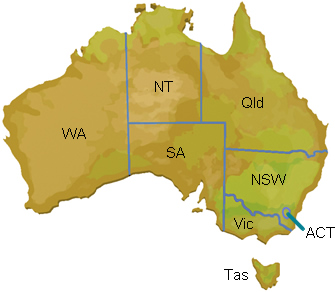
Australia is approx. 4000 kilometres wide (from the east coast to the west coast) and approx. 3200 kilometres ‘tall’ (from north to south). It is split into six states and two mainland territories: Western Australia, Queensland, New South Wales, Victoria, South Australia, Tasmania, Northern Territory and Australian Capital Territory. Each state and territory has its own capital city, but the national capital of Australia is Canberra, which is located in the Australian Capital Territory.
Population
Australia has a population of almost 27 million people (according to the Australian Bureau of Statistics as at 30 Sept. 2023), of whom about 50 per cent are female and 50 per cent are male (there is a slightly higher percentage of females, but it is very close).
Over a quarter of Australia’s population was born overseas, with most people immigrating from the United Kingdom, New Zealand and China. Australia prides itself on being a multicultural and diverse population. Many languages, cultures, foods, clothes and customs exist side-by-side in Australia.
Wildlife
Australia is a large island continent and has been isolated for hundreds of thousands of years. Because of this, Australia has many species of animals and plants which are unique to the country. For example, 773 of 869 Australian reptile species cannot be found anywhere else in the world. Likewise, Australia has 378 species of mammals, 80 per cent of which can only be found in Australia.
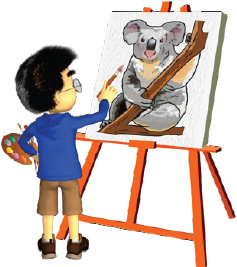
Of Australia’s mammals nearly half are marsupials. Marsupials account for some of Australia’s most famous and iconic creatures: the kangaroo, wallaby, koala, wombat and Tasmanian devil. Kangaroos are hugely iconic in Australia and it is estimated that their population varies between 15 and 60 million (allowing for seasonal changes).
Another type of Australian mammal is the monotreme. Monotremes are special because they are egg-laying mammals. Monotremes include the platypus and the echidna. An echidna resembles a hedgehog, while the platypus cannot be compared to any other creature. The platypus has a duck bill, furry body, webbed feet and a tail.
There are 828 species of birds in Australia, ranging from the large, but flightless, emu to the famous laughing kookaburra and the teeny fairy penguin. Australia has 55 species of parrots (such as the rainbow lorikeet, rosella and cockatoo) many of which are beautifully coloured.
Government
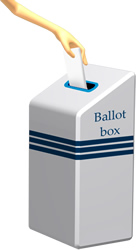
Australia is a democracy. This means that the people of Australia (everyone over the age of 18) vote to elect members of their community into parliament to make decisions and laws on their behalf.
In Australia, there are three levels of government: local councils, state and territory, and federal. Local councils are the first level and they make laws for their local council area. The next level is state and territory parliaments that make laws for their state or territory. The highest level of government is the federal parliament, which makes laws for the whole of Australia.
People have many different ideas and views about how Australia should be run. Often people who share similar ideas join together to form a group called a political party. There are various political parties that Australians can choose to vote for. After an election, the leader of the winning party, or parties, becomes the Prime Minister.
Australian symbols
What images strike you when you think of Australia? The beach? A barbeque? A cork hat? A cricket bat? Well, Australia actually has a range of symbols (or emblems) which officially represent the country.
The flag
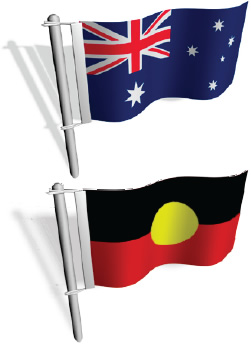
After Federation in 1901 (when Australia’s six colonies united), Australia required a flag to represent it as a nation. A design competition was launched which drew over 32,800 entries. Surprisingly, five of these entries were almost identical and were judged equal first.
The Australian flag is set on a blue background. The Union Jack sits in the top left corner to show Australia’s ties to Britain. The constellation of stars that is spread across the blue background is called the Southern Cross. This shows Australia’s geographic location in the Southern Hemisphere. The larger, seven-pointed star is called the Commonwealth Star. This star represents Australia’s government, and its seven points represent Australia’s states and territories.
The Australian Aboriginal flag was designed by Mr Harold Thomas. It is half black and half red, with a golden circle in the centre. The black top half of the flag symbolises Indigenous people. The red bottom half of the flag represents the colour of ochre and the red desert sand. The yellow orb at the centre represents the sun.
The coat of arms
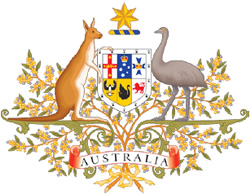
Australia’s first coat of arms was granted by King Edward VII in 1908. The coat of arms has since been altered. Within the shield appear the symbols of Australia’s six states. The border of the shield symbolises federation. The shield is held by two native animals, the kangaroo and emu. It is said that the animals were chosen as symbols of progress and moving forward, as neither animal is able to move backwards easily. Above the shield is a Commonwealth Star and surrounding the shield is Australia’s floral emblem, the golden wattle.
Flora and fauna
The golden wattle (Acacia pycnantha) became Australia’s official floral emblem in August 1988. The golden wattle also represents Australia’s national colours: green and gold. Every year, on 1 September, National Wattle Day is celebrated.
Many Australian states and territories have their own emblems. For example, South Australia’s floral emblem is the Sturt Desert Pea and Western Australia’s bird emblem is the black swan. Each state and territory also has its own coat of arms which incorporates its emblems.
Famous Australian attractions
Queensland
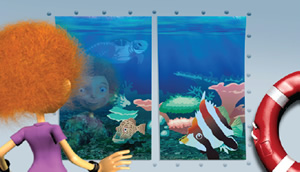
The Great Barrier Reef is a famed Queensland destination and is one of the seven natural wonders of the world. The Great Barrier Reef is a whopping 2000km long, stretching from Port Douglas to Bundaberg, and is the only living thing on earth that is visible from Space. The Great Barrier Reef is full of amazing sea creatures and bright coral, as well as tropical islands and sandy beaches. Queensland is also home to the Daintree Rainforest which is world heritage listed. It is also the world’s oldest tropical rainforest. The forest is home to zamia ferns, which are over 600 million years old, as well as to frogs, cassowaries, bats and butterflies.
New South Wales
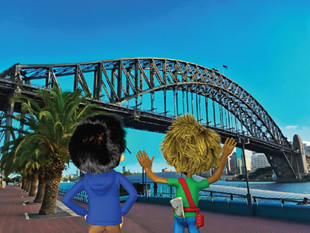
Sydney is a famous New South Wales tourist destination, attracting people with its iconic man-made structures such as the Harbour Bridge and the Opera House. The Sydney Opera House was designed by Jorn Utzon who submitted the winning entry in the Premier’s international design competition. The curves of the Opera House represent the sails of ships entering the harbour.
The Sydney Harbour Bridge took 1400 workers eight years to build. It is sometimes referred to as the coat hanger, due to the arched shape it forms between north and south.
Victoria
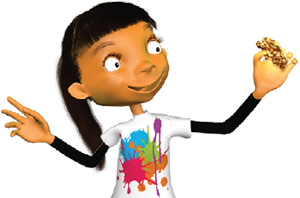
In 1851, gold was discovered in Victoria and New South Wales. Thousands of men and women from around Australia and the world were drawn to the goldfields hoping to make their fortune. However, few fortune hunters found the wealth they had been promised by the exaggerated rumours that filled the newspapers. Many lived a hard life on the goldfields and the discontent resulted in the bloody Eureka Stockade, where gold miners battled against government forces in 1854. You can still visit the famous goldfields in Victoria, as well as the site of the Eureka Stockade. Sovereign Hill in Ballarat uses actors in period costumes to recreate the excitement and frenzy of the nineteenth century goldfields.
South Australia
South Australia’s Kangaroo Island is a famous destination. The island has a fascinating variety of wildlife, including sea lions, fur seals, fairy penguins, pelicans, koalas, wallabies and, of course, kangaroos. Kangaroo Island offers a number of renowned locations such as Seal Bay, a beach popular with packs of sea lions enjoying its protected waters and warm sand. It also has a number of fascinating natural phenomena such as Admiral’s Arch, the Remarkable Rocks and the Kelly Hill Caves.
Tasmania
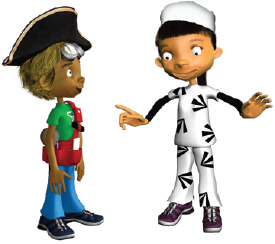
Tasmania was named Van Dieman’s Land until 1856. One of Tasmania’s most famous historic places is an old convict site called Port Arthur. Port Arthur was a prison for convicts from 1830 to 1877. During that time 12,500 convicts passed through the same buildings that you can walk through today. Many of the convicts were loaded onto ships and sent on the perilous voyage all the way from England for crimes as petty as stealing a loaf of bread to feed their family.
Western Australia
Western Australia is famous for its expansive and pristine coastline. The Coral Coast is renowned for its wildlife and natural scenery. In the waves of the Indian Ocean you can encounter dolphins, sea lions, manta rays, dugongs, humpback whales and whale sharks.
Inland from the coast is a desert landscape where you can find the Pinnacles. The Pinnacles are great limestone pillars that have formed naturally over millions of years, rising out of the yellow sand in Nambung National Park.
Northern Territory
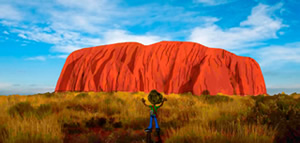
The Northern Territory contains one of Australia’s most iconic natural wonders: Uluru. Uluru is also known as Ayers Rock (named after Sir Henry Ayers).
Uluru is an inselberg, meaning ‘island mountain’. It is made from sandstone and is about 350m high and 9km around. Uluru is known to change colour at different times of the year, and even throughout the day at sunset or sunrise. The rock is extremely sacred to the Anangu people of central Australia and plays a significant role in their Dreaming stories.
Australian Capital Territory
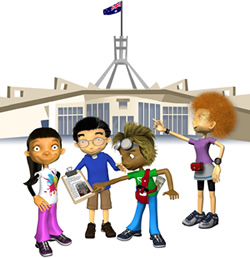
The Australian Capital Territory is home to one of Australia’s most iconic and symbolic buildings: Parliament House. It was opened in 1988 by Queen Elizabeth II and is made almost entirely of Australian materials including timber and marble. The architect Romaldo Giurgola designed Parliament House so that it was nestled within the hill. Parliament House boasts a large art collection which can be viewed by the public.
Australia fast facts
- Australians are a clever lot. They are responsible for inventing the notepad, aspirin, the pacemaker, the Hills Hoist clothesline, the dual-flush toilet and long-wearing contact lenses, just to name a few.
- Australia has 19 listed World Heritage properties, including the Sydney Opera House, Kakadu National Park and Uluru.

- Australia is the world’s sixth largest country (in area).
- Australia is an island continent. This means that it is completely surrounded by ocean.
- Only 6 per cent of Australian land is suitable for farming.
- 91 per cent of Australia is covered by native plants.
- Australia is the driest inhabited continent on Earth.
- There are over 300 mines in Australia, mining coal, zinc, silver, gold and more.
- Around 80 per cent of southern Australian marine species occur nowhere else in the world.
- During the gold rush in the 1850s, 60 per cent of all international immigrants to Australia headed straight for the Victorian goldfields.
- Native Australian food is called ‘bush tucker’. Local Aboriginal knowledge of insects and the plants that could supply edible roots, nectar, fruit and greens was essential to the survival of many European settlers and explorers.
- Australians enjoy a day of national celebration on Australia Day which is held on 26 January every year. This date marks the day the First Fleet arrived in Australia in 1788.
References
The following links will direct you to the homepage of the websites used as references for this topic.
- australia.gov.au: australia.gov.au
- Tourism Australia: www.australia.com
- Australian Bureau of Statistics (ABS): www.abs.gov.au
- Australian Government Department of Foreign Affairs and Trade: www.dfat.gov.au
- Australia Day: www.australiaday.org.au




